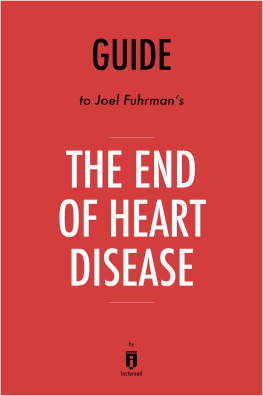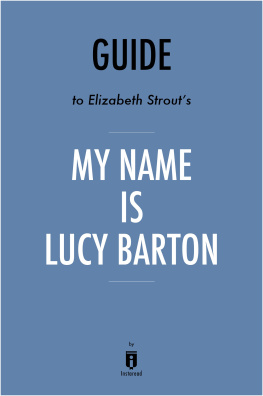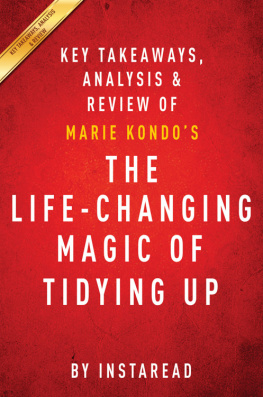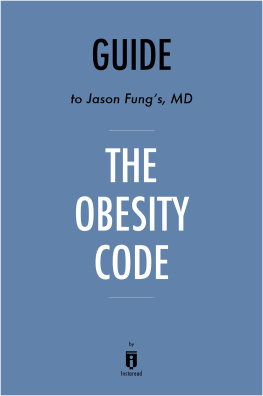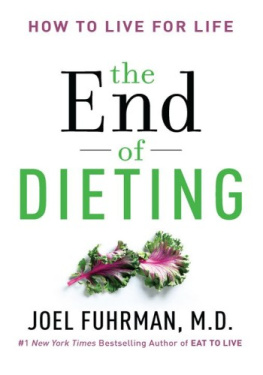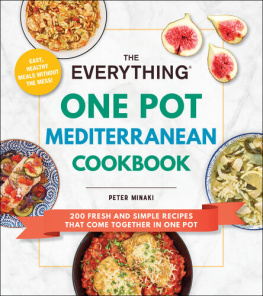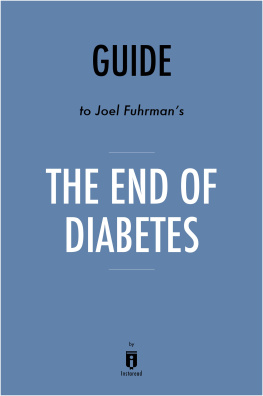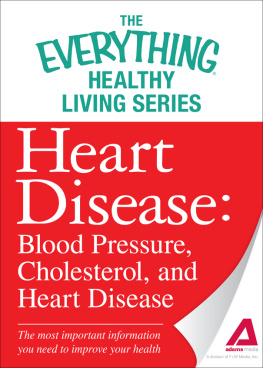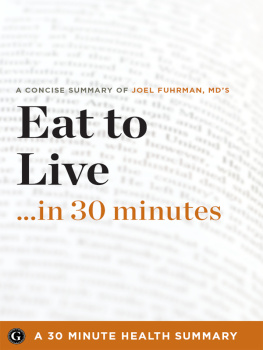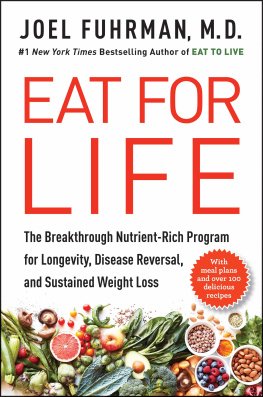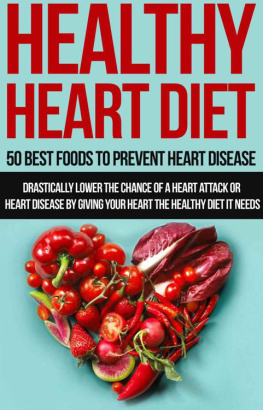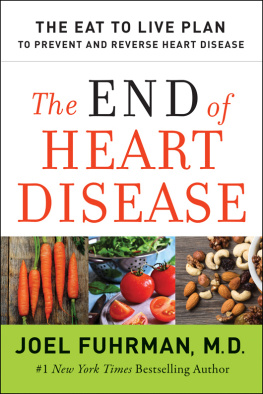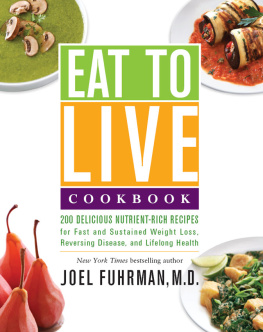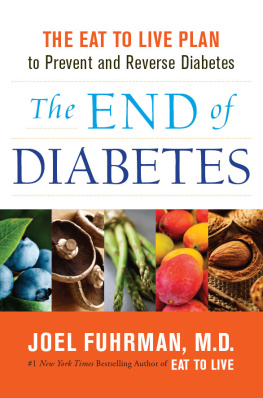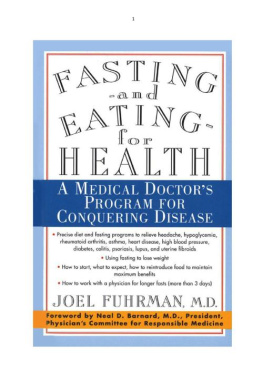Guide to
Joel Fuhrmans, MD
The End of Heart Disease
The Eat to Live Plan to Prevent and Reverse Heart Disease
by
Instaread
Please Note
This is a companion to the original book.
Copyright 2016 by Instaread. All rights reserved worldwide. No part of this publication may be reproduced or transmitted in any form without the prior written consent of the publisher.
Limit of Liability/Disclaimer of Warranty: The publisher and author make no representations or warranties with respect to the accuracy or completeness of these contents and disclaim all warranties such as warranties of fitness for a particular purpose. The author or publisher is not liable for any damages whatsoever. The fact that an individual or organization is referred to in this document as a citation or source of information does not imply that the author or publisher endorses the information that the individual or organization provided. This concise companion is unofficial and is not authorized, approved, licensed, or endorsed by the original books author or publisher.
Table of Contents
Overview
The End of Heart Disease is a call to action. Author Joel Fuhrman proclaims that the nations number one killer, heart disease, can be defeated with a simple choice: Either embrace a nutrient-rich diet or risk losing your life to a preventable heart condition. Most Americans unwittingly consume a diet that is slowly shortening their life and impinging on their health and well-being. Inevitably, poor health outcomes arise.
High blood pressure, high cholesterol, and heart conditions are particularly common among Americans because the typical American diet relies on high-sodium, processed foods, and animal products; it neglects the vast diversity of fruits, vegetables, beans, and nuts that Americans should be consuming instead. However, when these conditions land someone in the doctors office or the emergency room, patients are too often counseled to seek a quick but risky fix: a pill or a procedure. Neither pills nor surgery can address the underlying eating and lifestyle habits that cause and worsen heart conditions. Rarely do doctors counsel these patients to dramatically change their diets and lifestyles as a means to achieve improved outcomes. Even when doctors do provide this counsel, they seldom provide the detailed sort of action plan necessary to help patients arm themselves with the knowledge they need to succeed.
Only about 1 percent of people have a truly irreversible heart condition or defect. The remaining 99 percent of the population has the opportunity to protect its health and longevity. To do so, people should maximize the nutrient density in their diet by choosing foods that provide the most nutrients for each calorie they contain. Following this advice will naturally lead people away from the most dangerous foods, such as meats and refined sugars, in which calories are high and nutrients are few. Instead, seeking out the most nutrient-dense foods will lead people to vegetables, produce, beans, nuts, and seeds.
Important People
Joel Fuhrman is the author of The End of Heart Disease. He is a family physician and the bestselling author of several other books on health and nutrition including Eat to Live (2003), The End of Diabetes (2012), and The End of Dieting (2014). He advocates a nutrient-dense diet as a means to eradicate illness and achieve personal health.
Key Insights
- Heart disease is the number one killer of men and women in the United States.
- Death by heart disease is preventable with diet and lifestyle changes in 99 percent of people.
- A doctor who treats a patient with heart disease using only a prescription pad and without a full nutritional plan is engaging in malpractice.
- The Standard American Diet (SAD) is damaging.
- The Nutritarian diet is based on the equation that Health = Nutrients / Calories. In short, it recommends obtaining the maximum number of nutrients from a food for every calorie it provides.
- Heart bypass surgery and angioplasty are insufficient solutions to heart disease because they dont remedy the most dangerous plaque blocking the patients arteries. Nor do these procedures address the underlying cause of disease.
- The business of medicine risks losing money if people learn to treat themselves with their diets instead of turning to expensive drugs and procedures.
- Doctors and patients often prefer to treat and be treated with medicine because its easier than making changes to their practices and lifestyles.
- Health studies are often manipulated to show the results that those financing the research want to show.
Analysis
Key Insight 1
Heart disease is the number one killer of men and women in the United States.
Analysis
Every 90 seconds, someone in the United States dies of heart disease. [1] With one in four deaths in the United States caused by a cardiac condition, its unsurprising that nearly half of Americans possess several of the top three risk factors for this ailment: high blood pressure, high cholesterol, or a smoking habit. [2] All of these factors, however, can be reduced or eliminated by healthy choices. Heart disease need not be an inevitability. It is a danger that can be avoided by taking action.
Key Insight 2
Death by heart disease is preventable with diet and lifestyle changes in 99 percent of people.
Analysis
Only about 1 percent of the population has a heart condition that cannot be prevented or reversed by adopting a healthy diet and lifestyle. The other 99 percent of people have the choice to prevent or recover from heart disease primarily by changing their food intake. While doctors may offer surgery or drugs to patients presenting with a heart condition, a change of diet is the only intervention that does not come with major risks. Even the seemingly benign recommendation that people take an aspirin every day to prevent heart problems can hold risks of bleeding problems in the long term. However, a patient cannot make these major lifestyle changes and benefit from them without sufficient information.
It should be encouraging news that the power to fight premature death by heart disease is almost always in the patients own hands. However, for most people, the challenge of sticking to a diet is daunting enough to be a major deterrent from making much-needed, life-preserving changes. For one, the human brain is built to seek out and desire food as the very basis of the survival instinct. [3] Fighting that instinct triggers mental stress that can cause many people to respond by reaching for food. Because of this vicious cycle, a battle of willpower is not the answer. Instead, one psychologist at the University of Minnesota recommends simply making it harder to access unhealthy foods so people need not battle with their own willpower to make the right choice. [4]
Similarly, studies of the high failure rate on New Years fitness resolutions have shown that most people abandon their efforts to hit the gym or eat healthy because they are looking for results before changing their entire mindset toward their goals. [5] In short, its not enough to eat one healthy meal at a time or log daily workouts. Instead, to make a truly life-altering change such as the kind required to reverse or prevent heart disease, people must be willing to reinvent their overall vision for how food and exercise fit into their lives.
Key Insight 3
A doctor who treats a patient with heart disease using only a prescription pad and without a full nutritional plan is engaging in malpractice.
Analysis
The era of traditional medical care must come to an end. It is no longer ethical for a doctor to prescribe a drug to a patient without providing thorough and effective nutritional counsel. Many doctors may dismiss patients with a prescription and a brief reminder to eat well and exercise. However, merely saying those four words is not enough. Patients cannot be expected to understand what they must do without an action plan supported by their doctors. Furthermore, even if doctors provide a list of the risks of the medication they are prescribing, if they fail to weigh these risks against the greater benefits and lower risks of a healthy diet, they are neglecting their duty to properly educate the patient.
Next page
